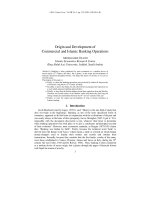Today origin and interpretation of sedimentary rocks
Bạn đang xem bản rút gọn của tài liệu. Xem và tải ngay bản đầy đủ của tài liệu tại đây (4.97 MB, 36 trang )
Today: Origin and Interpretation of Sedimentary Rocks
Wed: Origin and
Interpretation of
Metamorphic Rocks
Sedimentary Rocks — Why Care?
•
They are the repository of Earth’s history, especially the
history of how the surface environment (including life)
changed over time. To extract this history, we need to be
able to “read” this rock record.
•
They hold all of the oil, gas,coal, and water — locating
these materials requires an understanding of the
physical characteristics of different sedimentary rocks
and how those characteristics change in 3-D.
Coconino Sandstone
Coconino Sandstone up close
thin slice of Coconino
sandstone seen
through microscope
un-cemented quartz
sand grains from a
sand dune
So how are sedimentary rocks made?
Physical & Chemical Weathering → Sediment &
Dissolved Ions
hincks146-147
Sedimentary Structures
in the Coconino
This is the modern environment
where large cross-beds form
Wind Direction
Fig. 5.21abc
W. W. Norton
So cross beds are tilted in the direction of
flow (downstream)
Fig. 5.21d
Stephen Marshak
Uniformitarianism — depositional environments of
today are physically the same as ancient environments,
so clues from the modern can be used to infer ancient
environments from sedimentary rocks, or “the present is
the key to the past”
ripples
Stephen Marshak
Ancient ripples
Stephen Marshak
Mud cracks
Stephen Marhsak
Ancient mudcracks
Stephen Marhsak
Modern Alluvial Fan,
Death Valley
Fig. 5.24c
© Martin Miller
Ancient Alluvial Fan
Deposits
OOIDS
(made of calcite — CaCO₃)
imply shallow (<3m),
tropical marine depositional
environment
Monte Bove in Italy
800 meters
of oolitic
limestones
Ooids with cement,
seen in a thin section,
through a microscope
2 mm
So, the question is — how can we explain
such a thick pile of shallow-water
sediments?
We need to think about isostasy and sea
level change in our search for an
explanation of how we can get such thick
piles of sediment, all of which appear to be
deposited in fairly shallow water.









